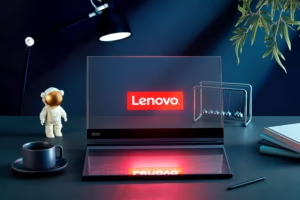Transparent laptops, once confined to the realm of science fiction, are now becoming a fascinating reality. Combining cutting-edge technology and innovative design, these devices push the boundaries of what we expect from modern computing. Let’s look into what transparent laptops are, the technology behind them, and their potential impact on the tech industry.
1. What Are Transparent Laptops?
These laptops feature displays, keyboards, or entire bodies made from translucent materials. These laptops allow users to see through certain parts of the device while retaining full functionality.
Key components of a transparent laptop may include:
- Transparent OLED displays: These allow vivid images and videos to appear on a see-through screen.
- Clear materials for casing and keyboards: Components like Gorilla Glass or clear polymers are used to achieve the desired transparency.
2. The Technology Behind Transparent Laptops
a. Transparent OLED Displays
The core technology enabling transparent screens is Transparent OLED (TOLED). Unlike traditional screens, TOLEDs use organic compounds to emit light, eliminating the need for backlights and creating a see-through effect.
b. Clear Conductive Materials
Transparent conductive materials, like indium tin oxide (ITO), are used in circuits to ensure the laptop functions without visible wiring obstructing the transparency.
c. Compact Hardware Design
To achieve a transparent appearance, components such as batteries, processors, and storage are strategically placed in non-transparent parts or minimized in size.
3. Potential Applications
a. Augmented Reality Integration
They can serve as AR tools, overlaying information on the display without obstructing the user’s view of their surroundings.
b. Presentation and Collaboration
In corporate or educational settings, transparent laptops could enhance presentations by making data visible to both presenters and audiences simultaneously.
c. Design and Aesthetics
For those prioritizing aesthetics, transparent laptops offer a sleek and futuristic appearance, ideal for creative professionals and tech enthusiasts.
4. Challenges in Development
a. Cost
The technology behind transparent components is still expensive, making these laptops a luxury product.
b. Durability
Transparent materials like glass or polymers may be more prone to scratches and damage compared to traditional laptop casings.
c. Privacy Concerns
The see-through nature of transparent laptops might pose challenges for users handling sensitive or private information in public spaces.
5. Transparent Laptops Available Today
While fully transparent laptops are not yet mainstream, several prototypes and partial implementations have been showcased:
- Lenovo’s Transparent OLED Prototype: Lenovo has demonstrated a transparent OLED laptop screen concept, sparking interest in the tech world.
- Xiaomi’s Mi TV Lux Transparent Edition: Though not a laptop, this transparent TV highlights the potential of transparent OLEDs in consumer electronics.
6. The Future of Transparent Laptops
They are a symbol of innovation and creativity in the tech industry. As manufacturing techniques improve and costs decrease, we could see these futuristic devices transition from novelty items to mainstream products.
Conclusion
They represent the fusion of technology and artistry, offering a glimpse into a world where devices seamlessly blend into their environments. While challenges remain, the possibilities for their application are endless, making them one of the most exciting developments in modern computing.
Would you invest in a these laptops for its aesthetic appeal, or do you prefer functionality over form? Let’s discuss!

